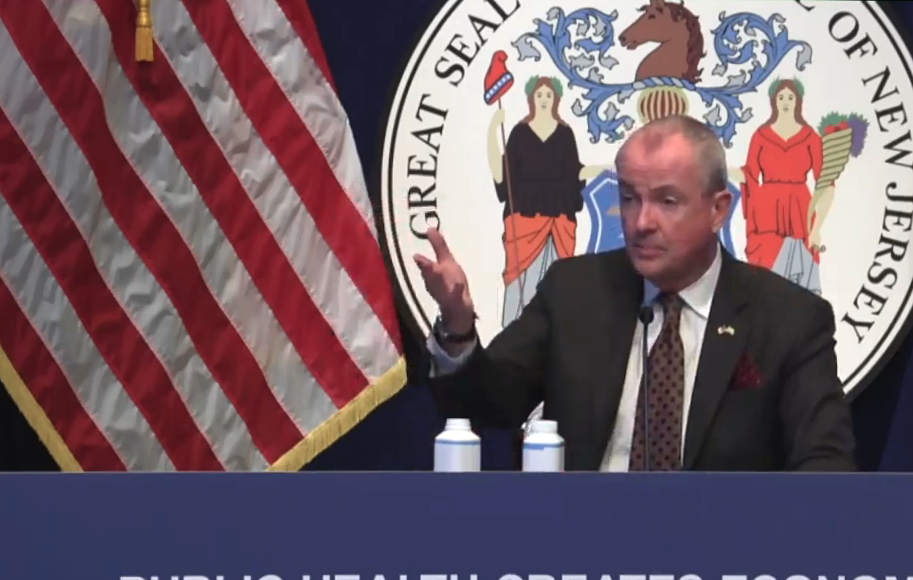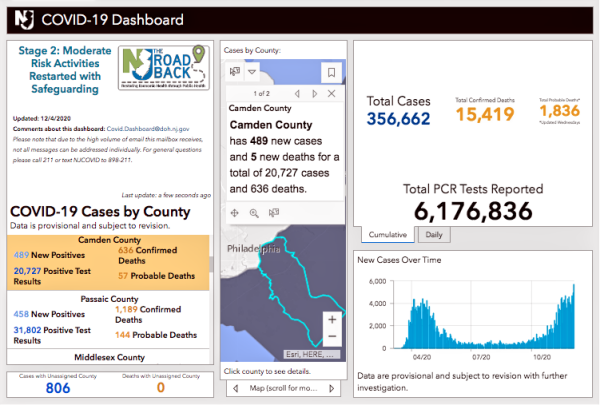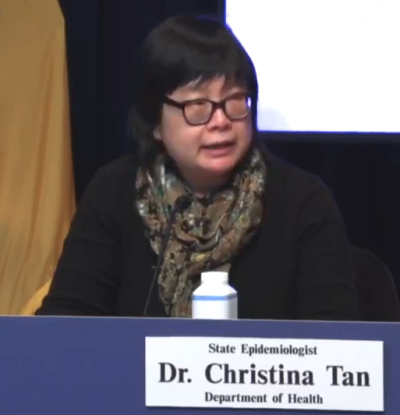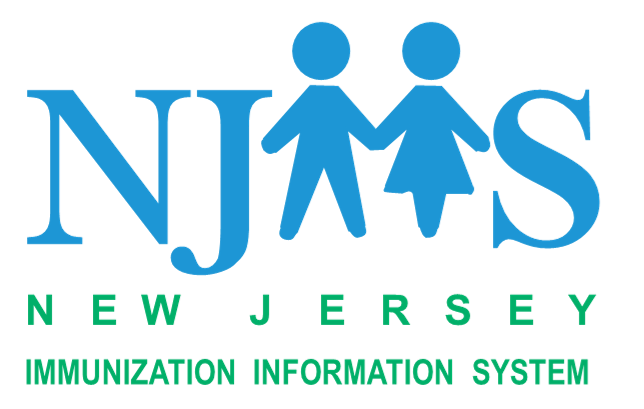Unemployment claims were up for the first time in a few weeks, but those who’ve exhausted their benefits may have help from a new law Gov. Murphy signed today.
By Matt Skoufalos | December 4, 2020
Another 5,673 New Jersey residents have tested positive for novel coronavirus (COVID-19), bringing the statewide total to 356,662 cases, Governor Phil Murphy reported Friday.
Sadly, 48 more residents have perished from complications related to the virus, bringing the statewide death toll to 15,419 lives lost during the pandemic.
In addition to those lab-confirmed fatalities, the state has acknowledged another 1,836 probable COVID-19-related deaths.
Since March, 478 of every 100,000 New Jersey residents have been hospitalized with COVID-19, and 175 of every 100,000 have died from COVID-19-related complications.
More than 6.17 million polymerase chain reaction (PCR) tests for COVID-19 have been performed statewide, with a 3.99-percent positivity rate per 100,000 residents.
Rate of transmission (Rt) at 1.08, spot positivity highest in South Jersey
The statewide average of COVID-19 spot positivity testing stood at 10.42 percent November 30; in South Jersey, it was highest, at 11.6 percent.
Rt, the variable that describes the seven-day, rolling-average, statewide rate of transmission of new COVID-19 cases, fell to 1.05 from samples taken December 2.
An Rt figure greater than 1.0 means that each new COVID-19 patient is infecting more than one other person, on average, and the spread of the virus is increasing.
Since its mid-April COVID-19 spike, the highest reported RT in New Jersey was 1.48, recorded August 1. The lowest was 0.62, recorded June 9.
Hospitalizations climb, new cases of pediatric multi-system inflammatory illness
Throughout New Jersey, 3,315 people currently are hospitalized with a suspected (242) or confirmed (3,073) case of COVID-19, Murphy said.
Yesterday 385 COVID-positive patients were admitted to New Jersey hospitals, while 362 were discharged.
Among those hospitalized patients, 615 were in intensive or critical care, and 386 of the ICU and critical-care patients (63 percent) are on ventilators.
Across the state, long-term care (LTC) centers have reported 1,029 cumulative outbreaks of COVID-19, and 342 are dealing with an active outbreak. LTCs account for 43,043 infected patients and staff in New Jersey, or 12 percent of total cases.
That includes 26,962 residents and 16,081 staffers sickened by the virus, as well as 7,328 lab-confirmed resident and staff deaths (48 percent of the statewide total), with facilities self-reporting 122 staff deaths.
Of 656 veterans residing in three state-run homes, 408 residents have tested positive for COVID-19, and 146 have died from complications related to the virus. Nine veterans presently are hospitalized with COVID-19, and 250 have recovered from the virus.
At state-run psychiatric facilities, 263 of 1,172 patients and 684 staff members have tested positive for COVID-19. Fourteen patients and seven staffers have died from complications related to the virus.
To date, 63 New Jersey children aged 1 to 18 have been diagnosed with pediatric multi-system inflammatory syndrome, New Jersey State Epidemiologist Dr. Christina Tan said—two more than previously announced.
All those pediatric patients have tested positive for an active COVID-19 infection or the presence of COVID-19 antibodies, indicating exposure to the virus. No deaths have been associated with this syndrome in New Jersey, although several children have been hospitalized during their treatment.
Since August 1, 70 COVID-19 outbreaks encompassing 285 individual cases have been traced to schools in 18 New Jersey counties. In Camden County, 10 outbreaks have been linked to 57 cases. That’s the most in the state.
New Jerseyans who get COVID vaccine will be opted into NJIIS for dose management
With the first distribution of COVID-19 vaccines from Pfizer anticipated to ship to New Jersey 24 hours after their emergency approval from the U.S. Food and Drug Administration—possibly as early as next week—the state is looking to coordinate management of the two-dose immunizations through its Immunization Information System (NJIIS).
The system, described by the state Department of Health as a “confidential, population-based online system that collects and consolidates vaccination data,” will be leveraged to help patients who receive COVID-19 vaccines track both of the two-dose inoculations.
Under Murphy’s executive order, anyone receiving the first dose will be automatically opted-into NJIIS to coordinate their receipt of the second dose. New Jersey residents born after 1998 are already automatically enrolled in the system. The governor said that anyone who wishes to withdraw from it may do so 30 days after the conclusion of the public health crisis, as defined by the state of emergency declaration.
“We’re doing this for a simple reason: to ensure that those who choose to receive a vaccine get the most effective course in the most streamlined manner possible, on the proper timetable, and without logistical or bureaucratic hurdles in the way,” Murphy said.
“If you wish to be vaccinated against COVID-19, you don’t have to first opt into the system to make sure that your two-dose regimen is properly tracked and managed,” he said.
Pfizer is expected to ship a total of 76,000 doses to start, enough to vaccinate 38,000 residents, with new doses arriving weekly thereafter. A COVID-19 vaccine from Moderna is anticipated to receive approval from the FDA in short order as well.
Unemployment up, but new law adds 20 weeks of benefits
New Jersey saw another 13,542 new unemployment claims filed last week, up by 1,350 week over week, Murphy said.
According to the governor, those numbers were driven “largely by the reopening of existing claims by school food service workers and bus drivers over the Thanksgiving break.”
More than $1.8 million workers have filed for unemployment assistance since the start of the pandemic, and $19.5 billion has been disbursed to eligible workers.
For those who have exhausted their state and federal benefits, Murphy also signed a law expanding their eligibility for 20 weeks of extended unemployment benefits. The new law affords additional opportunities for those who have been out of work to qualify for those payouts.







